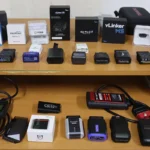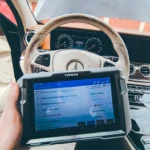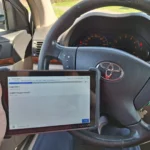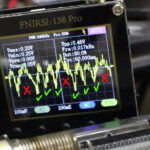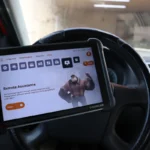The code P0140: O2 Sensor Circuit No Activity Detected (Bank 1 Sensor 2) points out a fault in the oxygen sensor’s activity, and most likely is caused by sensor malfunctions or issues in the related wiring and components.
P0140 quick overview
| Meaning | P0140: O2 Sensor Circuit No Activity Detected (Bank 1 Sensor 2) |
| Is it serious? | Moderately serious. While the vehicle might still run, it can lead to decreased fuel efficiency, increased emissions, and potential damage to the catalytic converter if not addressed. |
| Possible causes | – Faulty or failing oxygen sensor – Damaged or corroded wiring or connectors – Vacuum or intake leaks – Incorrect fuel type (e.g., using E85 instead of regular gasoline) – Malfunctioning EGR valve – Issues with related components like the IAC |
| How to diagnose? | 1. Use a diagnostic scanner to confirm the P0140 code and check for any other related codes. 2. Visually inspect the O2 sensor and its wiring for any visible damage or disconnections. 3. Conduct a smoke test to identify any vacuum or intake leaks. 4. Monitor the O2 sensor’s readings using a scanner, especially during different RPM ranges. 5. Check the vehicle’s fuel type and ensure it’s the correct type recommended by the manufacturer. 6. Examine related components like the EGR valve and IAC for proper function. 7. If the O2 sensor readings are consistently out of range, consider replacing the sensor. 8. After any repairs, clear the code and test drive the vehicle to see if the code returns. |
| What is Bank 1 sensor 2? | Downstream oxygen sensor for engine head 1. Check Bank1 vs Bank2 explanation for the detailed explanation. |
Free PDF: How to choose OBD2 scanner

I’ve made you a free PDF to choose the OBD2 scanner in 5 minutes.





PDF is 100% free and it is designed to help you pick a scanner in less than a few minutes! Not a boring 50-page guide.
Just tell me where to send it.
How to fix P0140 – learn from mechanics
I looked into P0140 service cases at iatn.com website where in the private forums the mechanics seek advice from other mechanics. I looked up a bunch of cases to help you decide how to fix your issue and see what would a real mechanic do to solve it.
Case #1: Dodge
- Vehicle Information:
- 1997 Dodge AVENGER 2.5L
- Issue + Repair History:
- MIL Lamp on.
- Fault Code: p0140 (o2 sensor bank 1 sensor 2 stuck at center).
- Upon scanning, it was observed that the readings for bank1 sensor2 were mimicking bank1 sensor1. After clearing the codes and conducting a road test, the code reset. There was confusion regarding the placement of sensor 2, which was upstream of the converter, as it was expected to be downstream to monitor the converter. The technician was unsure about the logic behind this placement and wanted to confirm before replacing the O2 sensors.
- Community Suggestions:
- It might be a lazy O2 sensor.
- Check and recheck the data to pinpoint a fault.
- Final Fix:
- After thorough checking and not being able to pinpoint a specific fault, the O2 sensor was replaced, and the system was reset. The vehicle was then returned to the customer. The issue seems to have been resolved as there have been no complaints for a few days after the fix.
Case #2: Pontiac
Vehicle Information:
- 2001 Pontiac Grand Prix SE 3.1L
Issue + Repair History:
- MIL Lamp on.
- Fault Codes: po140b (o2 B1S2 inactive) and o2 B1S2 heater circuit codes.
- Initially, B1S2 o2 was replaced and codes were cleared. However, the vehicle returned with the same codes. The heater circuit tested good and o2 showed readings between .420v-.480v. The o2 was replaced again with a Bosch brand, but the vehicle returned with only the po140b code. The technician was puzzled as to why the vehicle didn’t set a CAT code if the cat wasn’t storing enough o2.
Community Suggestions:
- Record and view the O2 on a line chart to check if the O2 is staying rich or lean for extended periods, which could indicate a malfunctioning CAT.
- Check for O2 activity before the cat lights off on the rear sensor. An inactive cat will show a steady output voltage from the sensor after it lights off.
- Consider the possibility of repeat O2 failures on Bosch O2’s in GM vehicles and try using Delco or OE sensors.
- Check the PCM, PCM ground, and grounded circuit in cylinder head temp sensors.
- Replace the O2 sensor with a GM/AC Delco part instead of Bosch.
- Consider replacing the catalytic converter, especially if the vehicle has a three-way cat.
- Ensure battery voltage to the heater b+ circuit and good grounds. Check the ground circuits to read less than 0.05 volts.
Final Fix:
- The issue was traced to a broken wire (ppl/white) in the harness near the trans grounds, which was the main harness for the PCM. The wire was the signal one. The technician ran a new wire and cleared the code, resulting in good switching data with the scan tool and no code recurrence.
Case #3: Volkswagen
Vehicle Information:
- 1996 Volkswagen Jetta GLS 2.0L
Issue + Repair History:
- MIL Lamp on.
- Fault Codes: p0132 (no upstream o2 signal) and later p0140 (downstream o2-no signal).
- A vacuum leak was repaired and the upstream o2 sensor was replaced due to limited voltage switching. However, the car returned with the p0140 code. During testing, the downstream o2 varied in voltage, especially under heavy throttle, but no 1-trip trouble code was set.
Community Suggestions:
- The broken wire issues on the 1996 models were at the o2 sensors themselves. The factory’s method of installing the o2 sensors could cause internal wire damage. If the rear sensor has broken wires, it might cause a “slow response” fault from the front sensor.
- If the catalytic converter is functioning, the rear o2 readings should remain steady. Due to issues with the pre-cat o2 sensor, rear sensor codes might have been overlooked by the ECU.
- The o2 sensor seems to warm up slowly. Consider replacing it, as both sensors might have been updated.
Final Fix:
- The car had a faulty downstream o2 sensor. Although no broken wire was found, the original o2 had no crosscounts and wasn’t quite fixed voltage. After replacing the o2 sensor, good crosscounts were observed on the downstream o2.
Case #4: Chevrolet
Vehicle Information:
- 2005 Chevrolet Trailblazer LS 4.2L
Issue + Repair History:
- MIL Lamp on.
- Fault Codes: po140 (secondary air injection system).
- The technician installed a new air pump and relay on their own Trailblazer, which worked fine. However, this particular Trailblazer keeps returning with the same code. The technician had previously repaired a vacuum leak and replaced the upstream o2 sensor. Despite these repairs, the car returned with a new code related to the downstream o2.
Community Suggestions:
- Check for broken wire issues at the o2 sensors themselves, which were a known issue for the 1996 models.
- The air control valve on the rear of the head might be the cause of the code.
- The air injection pump shut off valve is a common failure point.
- Monitor the system using the O2 sensor before the catalyst and ensure the diverter valve works properly.
- Check the air solenoid relay and power it up to test the control valve.
- Ensure the code wasn’t mistakenly identified as po410, which relates to an air pump problem.
Final Fix:
- The issue was with the air valve on the side of the head, which was stuck. The technician recommends not cleaning it but replacing it. After replacement, the MIL light did not return.
Case #5: Mazda
2002 Mazda Protege DX 2.0L Poor Idle Quality, Cuts out, MIL Lamp on
- Vehicle Information:
- 2002 Mazda Protege DX 2.0L
- 2002 Mazda Protege DX 2.0L
- Issue + Repair History:
- On starting, both O2 sensor readings drop very low (sensor 1 at 0.035, sensor 2 at 0.100).
- Smoke test conducted with no issues found.
- Fuel pressure is within the normal range.
- Coolant and intake air temperature are within range.
- Throttle position sensor sweeps correctly.
- Mass air flow sensor readings are within range.
- O2 sensor has proper ground and power.
- When the computer increases long-term fuel trim to 25%, O2 sensors start to swing between rich and lean.
- A new MAF was ordered and replaced, but there was no change.
- The car has a new fuel pump and EGR valve.
- Codes reported: p0131 (O2 sensor circuit voltage low sensor 1) and p0140 (O2 sensor circuit no activity bank 1 sensor 2).
- Other test results: fuel pressure at 40, smoke test was okay, valve timing was okay, and manifold vacuum reading at idle was 15 in.
- Suggestions from the Community:
- It’s not unusual for these Mazdas to show low voltage readings from O2 sensors at idle. Increasing the RPM might help get a waveform from the O2 sensor. There might be issues with the IACs; cleaning or replacing them might help.
- Check the intake gasket for leaks.
- Look at short-term and long-term fuel trims at both idle and 2500 RPMs. If there’s a problem only at idle, check for vacuum leaks.
- Check the EGR valve for sticking open.
- 15 inches of vacuum might be normal in Denver but is considered low in other places.
- Check if the timing belt was recently replaced; it might be off by a tooth.
- Final Fix:
- The car had E85 fuel in the gas tank. After draining it and refilling with regular gas, the O2 sensors started switching properly, and the fuel trim could control.
How to diagnose P0140
I made you an overview of solving this DTC, based on all the advice that was suggested by certified mechanics to address this issue in previously mentioned service cases.
- Check for Proper Fuel Type:
- Ensure the correct type of fuel is used (e.g., regular gas instead of E85).
- Inspect O2 Sensors and Wiring:
- Examine the O2 sensors for any damage or malfunction.
- Check the wiring, especially at connectors and the sensor itself, for breaks or damage.
- Vacuum and Intake Leaks:
- Conduct a smoke test to identify any vacuum or intake leaks.
- Pay special attention to the intake gasket.
- Monitor O2 Sensor Readings:
- Use a scanner to monitor O2 sensor readings, especially during different RPM ranges.
- Check both short-term and long-term fuel trims.
- Examine Related Components:
- Check the EGR valve for sticking or malfunction.
- Inspect the IAC (Idle Air Control) and consider cleaning or replacing if necessary.
- Consider Timing Issues:
- If a timing belt was recently replaced, ensure it’s not off by a tooth.
- Sensor Replacement:
- If in doubt, consider replacing the O2 sensor, especially if readings are consistently out of range.
- Use OEM or recommended parts for replacements.
- Check for Technical Bulletins:
- Look for any manufacturer bulletins related to the fault code for specific guidance or known issues.
Free PDF: How to choose OBD2 scanner

I’ve made you a free PDF to choose the OBD2 scanner in 5 minutes.





PDF is 100% free and it is designed to help you pick a scanner in less than a few minutes! Not a boring 50-page guide.
Just tell me where to send it.



